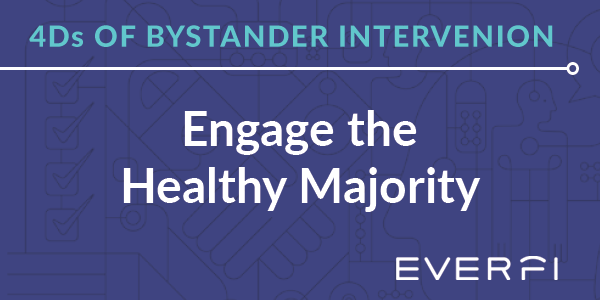We’ve likely all heard the phrase, “if you see something, say something.” Now that phrase is making its way into workplaces around the country as organizations continue to look for new ways to address the age-old problem of harassment. But, can a simple tag line work as well as a measurable bystander intervention program? In an effort not only to emphasize their commitment to creating non-hostile work environments but also to elicit employee assistance in driving out bad behaviors, employers are increasingly training employees on how they can play powerful bystander roles.
Traditional harassment prevention has taken a primarily punitive tone—focused on what employees should not do, versus what they should do. Reframing the focus from “don’ts” to “do’s” can be a much better way to help bystander intervention training programs have a real impact—and to engage employees as bystanders and allies versus potential victims and harassers.
Do you know how much harassment could be costing your company? Calculate now.
Engaged Bystander Intervention Activities
In some states, bystander intervention activities are not being left to chance. In California, Senate Bill 1300 enacted in 2018 authorizes employers to provide a bystander intervention program “that includes information and practical guidance on how to enable bystanders to recognize potentially problematic behaviors and to motivate bystanders to take action when they observe problematic behaviors.” In New York City, training must include “information concerning bystander intervention, including but not limited to any resources that explain how to engage in bystander intervention.”
While initial reactions to these mandates may be: “So, we’re supposed to ask our employees to be the harassment cops? They’ll never do that,” in reality, bystander intervention is not about having employees swoop into a problematic situation to save the day with a flourish. Rather, bystander intervention training gives employees the skills to take small actions that help create and maintain respectful work environments.
Bystander intervention can take a variety of forms from interrupting the harassment to informally addressing the harassment after the fact, to formally reporting the harassment, to encouraging others’ allyship in ensuring a positive work environment.
Bystander Intervention Examples: Options for Action
In a recent webinar, “Your Sexual Harassment Training May Be Doing More Harm Than Good,” Dr. Shannon Rawski, a leading expert on workplace harassment, with the University of Wisconsin Oshkosh, and Elizabeth Bille, an employment law attorney and subject matter expert on the prevention of harassment and discrimination in the workplace, presented what some bystander intervention examples might look like:

- Distract. An employee observes an interaction between two coworkers that concerns her. She thinks: “I’m going to cause a distraction by removing Jon from the situation.” She approaches Jon and says: “Hey Jon, the team needs you to look at our presentation in the conference room. Can you come now?”
- Delegate. In a second situation, an employee observes a colleague making what she feels is an inappropriate comment to another employee. She doesn’t feel comfortable acting alone in the moment but realizes she can help by getting assistance from others. She thinks: “I’m going to take my concerns directly to HR.”
- Delay. Third, an employee can check in with the target of the concerning behavior to offer support, ask if they were comfortable with what just happened, and if they were uncomfortable, encourage them to report the interaction to HR.
- Direct approach. An employee observes another employee’s behavior and thinks: “Whoa, that joke definitely felt inappropriate. Maria is always doing that. I bet if I’m feeling like this isn’t okay, other people are too. I’m going to say something directly.” The employee can say: “Hey, let’s keep it professional.”
Employees will vary in their level of comfort in addressing situations and can benefit from understanding a variety of positive actions that they might take—as well as resources the company provides that can help them fulfill the bystander role effectively.
Resources for Bystanders
Bystander intervention programs, like workplace harassment training generally, should be a process, not an event. A one-time training session will not prepare employees to effectively serve in a bystander role. Ongoing communication, education, and support will.
Arm bystanders with information on how to report incidents, how to respond to an accusation, how the investigation process works and how progressive discipline systems work. As Dr. Rawski has noted, this information can be presented to bystanders as useful tools that they can use for any situation they encounter, including assisting targets (those who are the subject of harassment) and those whose behavior may make others uncomfortable. This provides a more effective message than just “you need this information because you may be a victim in the future.” Teach them how to approach situations from a positive frame of mind, assuming good intentions. Individuals who cause harm also need to be provided with information about how their words or actions may be impacting others and how to modify their behaviors to support a culture of respect for all.
A focus on professionalism, as opposed to illegal behavior, can serve as a foundation for shared understanding by all. Identifying unprofessional behavior is easier—and less intimidating—for employees than identifying legal violations. By doing so, employees will be more prepared to actively step in or speak up when they see the warning signs of harassment–unprofessional, disrespectful, or intimidating behavior–rather than waiting until the most egregious misconduct occurs before flagging it.
The campaign to “see something, say something” may raise awareness, but a good bystander intervention program arms individuals with what to look for and what to say is how we move the needle on preventing harassment before it starts.


